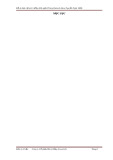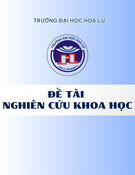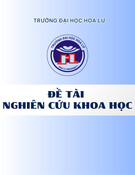
RESEARC H Open Access
Upregulated expression of indoleamine 2,
3-dioxygenase in CHO cells induces apoptosis of
competent T cells and increases proportion of
Treg cells
Jingyan Sun
1†
, Jinpu Yu
2†
, Hui Li
2
, Lili Yang
2
, Feng Wei
2
, Wenwen Yu
2
, Juntian Liu
1*
and Xiubao Ren
2*
Abstract
Introduction: The inflammatory enzyme indoleamine 2, 3-dioxygenase (IDO) participates in immune tolerance and
promotes immune escape of IDO+ tumors. A recent hypothesis suggested that IDO may contribute to the
differentiation of new T regulatory cells (Tregs) from naive CD4+ T cells. In this study we investigated the role of
IDO in induction of immunosuppression in breast cancer by increasing the apoptosis of T cells and the proportion
of Tregs.
Methods: An IDO expression plasmid was constructed and Chinese hamster ovary (CHO) cells were stably
transfected with human IDO. Purified CD3+ T cells were isolated from the peripheral blood monouclear cells of
breast cancer patients. After co-culturing IDO expressing or untransfected (control) CHO cells with T cells, T cells
apoptosis were determined by flow cytometry analysis and annexin-V and PI staining. The proportion of the
regulatory T cell (Tregs [CD4 + CD25 + CD127-]) subset was measured by flow cytometry analysis. T cells total RNA
and cellular protein samples were isolated for detecting Foxp3 gene and protein expression.
Results: IDO transgenic CHO cells yielded high levels of IDO enzymatic activity, resulting in complete depletion of
tryptophan from the culture medium. We found that apoptosis occurred in 79.07 ± 8.13% of CD3+T cells after co-
cultured with IDO+ CHO cells for 3 days and the proportion of CD4 + CD25 + CD127- T cells increased from 3.43
± 1.07% to 8.98 ± 1.88% (P< 0.05) as well. The specific inhibitor of IDO,1-MT efficiently reversed enhancement of T
cells apoptosis and amplification of Tregs in vitro. Increased expression of Foxp3, a key molecular marker of Tregs,
was confirmed by RT-PCR, real-time RT-PCR and Western blot analysis at the same time.
Conclusions: These results suggest that IDO helps to create a tolerogenic milieu in breast tumors by directly
inducing T cell apoptosis and enhancing Treg-mediated immunosuppression.
Keywords: Indoleamine-Pyrrole 2, 3-Dioxygenase, breast neoplasms, immune tolerance, CHO Cells, regulatory T-
Lymphocytes
* Correspondence: juntian_liu2001@yahoo.com.cn; rwziyi@yahoo.com
†Contributed equally
1
Department of Breast Oncology, Tianjin Medical University Cancer Institute
and Hospital, Tiyuanbei, Huanhuxi Road, Hexi District, Tianjin, 300060, China
2
Department of Immunology, Key laboratory of Cancer Prevention and
Therapy, Tianjin Medical University Cancer Institute and Hospital, Tiyuanbei,
Huanhuxi Road, Hexi District, Tianjin, 300060, China
Full list of author information is available at the end of the article
Sun et al.Journal of Experimental & Clinical Cancer Research 2011, 30:82
http://www.jeccr.com/content/30/1/82
© 2011 Sun et al; licensee BioMed Central Ltd. This is an Open Access article distributed under the terms of the Creative Commons
Attribution License (http://creativecommons.org/licenses/by/2.0), which permits unrestricted use, distribution, and reproduction in
any medium, provided the original work is properly cited.

Introduction
The molecular mechanisms underlying tumor-induced
tolerance are the subject of active research, and a num-
ber of contributing mechanisms have been identified.
Indoleamine 2, 3-dioxygenase (IDO/INDO), an impor-
tant enzyme in the metabolism of tryptophan, catalyzes
the rate-limiting step of tryptophan degradation along
the kynurenine pathway. Reduction in the local trypto-
phan concentration and generation of tryptophan meta-
bolites can suppress T cell proliferation or induce T cell
apoptosis [1,2], and IDO has been implicated in the
endogenous induction of peripheral tolerance and
immunosuppression [3,4]. In addition, many human
solid tumors express IDO, indicating that it may contri-
bute to the induction of tumor tolerance [5-8].
Regulatory T cells (Tregs [CD4+CD25+CD127-]) can
inhibit most types of immune responses and are emer-
ging as a key component of acquired tolerance to
tumors [9]. Increased Treg activity facilitates tumor
growth, whereas depletion of Tregs allows for effective
anti-tumor immune responses [10]. Previous studies
have shown that IDO is expressed in tumor-draining
lymph nodes. Interestingly, we previously found that
IDO expression in primary breast cancer tumors is
accompanied by Treg infiltration (unpublished data),
suggesting a correlation between IDO activity and Tregs
in these tumors. However, the role of increased IDO
expression in tumor cells in development of Treg cells
is not clear. In this study, we investigated the potential
effects of IDO on development of Treg cells in breast
cancer tumors using a stable IDO-expressing Chinese
hamster ovary (CHO) cell line.
Materials and methods
Cell lines and culture conditions
The Chinese hamster ovary (CHO) cell line was pur-
chased from the Shanghai Institute of Cell Biology, Chi-
nese Academy of Sciences (Shanghai, China). The breast
cancer cell line MDA-MB-435s was obtained from
American Type Culture Collection (Manassas, VA).
Both cell lines were maintained in culture as adherent
monolayer in RPMI-1640 (Gibco, Invitrogen Corp.,
Carlsbad, CA) medium supplemented with 10% fetal
bovine serum (FBS), L-glutamine (1%) and penicillin
(0.1%). Cells were incubatedat37°Cinahumidified
atmosphere with 5% CO2.
Construction of a recombinant plasmid containing human
IDO cDNA
Total RNA was isolated from breast cancer MDA-MB-
435s cells using Trizol (Invitrogen, Carlsbad, CA)
according to the manufacturer’s instructions. A 1225 kb
fragment encompassing the entire coding region of
human IDO cDNA was obtained using RT-PCR (Takara,
Dalian, China) with the following primer pair: sense 5’-
AGATCTGCCACCATGGCACACGCTATGGAAAAC-
3’,andantisense5’-GTCGACTTAACCTTCCTT-
CAAAAGGGATTTC-3’. The PCR products were
inserted into the pMD19-T Simple Vector (Takara)
using TA-cloning procedures, and sequencing analysis
was used to identify the product of interest (pMD19-
IDO).
Establishment of stable transformants
For construction of stable transformants, pMD19-IDO
and pIRES2-EGFP (Clontech, Santa Clara, CA) were
digested with BglII and SalI. The fragments of interests
were recovered by agarose gel analysis, purified and
ligated using T4 DNA ligase to generate the expression
plasmid pIRES2-EGFP-IDO. The recombinant expres-
sion plasmid was confirmed by digestion with BglII and
SalI and sequencing. CHO cells were cultured in RPMI
medium 1640 with 10% FBS for 24 h and then trans-
fected with 10 μg of pIRES2-EGFP-IDO using a stan-
dard electroporation method (field strength of 350 V/
cm, 60 μs, 1 pulse). The pIRES2-EGFP vector was used
as a plasmid control, and CHO cells transfected with
pIRES2-EGFP (CHO/EGFP) were used as a control cell
line. The CHO/EGFP cells were established as described
previously [11]. G418 (1 mg/ml) was added to the med-
ium 48 h after transfection, and the medium was chan-
ged every 48 h for 4 weeks to obtain G418-resistant
transformants. CHO cells containing pIRES2-EGFP-IDO
were then identified by flow cytometric analysis.
Detection of IDO gene transcripts in CHO cells and Foxp3
in co-cultured cells by RT-PCR
To investigate IDO gene integration into CHO cells,
total RNA was isolated from CHO cells transfected with
pIRES2-EGFP-IDO using Trizol. RT-PCR primers were:
IDO (188 bp), sense 5’-CATCTGCAAATCGTGAC-
TAAG-3’;antisense5’-CAGTCGACACAT-
TAACCTTCCTTC-3’.b-actin (186 bp) was used as an
internal control; sense 5’-TGGCACCCAGCACAAT-
GAA-3’;antisense5’-CTAAGTCATAGTCCGCCTA-
GAAGCA-3’. cDNA was prepared by Oligo-(dT)15 from
1μg of total RNA, and PCR was performed using a RT-
PCR kit (Takara) according to the manufacturer’s
instructions. To analyze Foxp3 gene expression in co-
cultured cells, total RNA was isolated using Trizol as
described above, with Foxp3 (488 bp) primers, forward
primer 5’-CCCACTTACAGGCACTCCTC-3’; reverse
primer 5’-CTTCTCCTTCTCCAGCACCA-3’.RT-PCR
was performed in a volume of 20 μL using 50 ng of
RNA, 2 μL of 10× PCR buffer (Takara, Japan), 10 mM
of each deoxynucleoside triphosphate (dNTP), 1 μLof
each primer, 0.5 μL of Takara Taq polymerase and 13.5
μL of water. Conditions were 94° for 5 min, followed by
Sun et al.Journal of Experimental & Clinical Cancer Research 2011, 30:82
http://www.jeccr.com/content/30/1/82
Page 2 of 10

30 cycles of 30 s at 94°C, 30 s at 60°C, and 1 min at 72°
C, with a final extension cycle of 72°C for 10 min. PCR
products were analyzed by separation on 2% agarose
gels.
Quantitative real-time RT-PCR detection of Foxp3
Foxp3 gene expressions in T cells from different co-cul-
tures were also assessed by quantitative real-time RT-
PCR using b-actin mRNA as an internal control. Foxp3
primers, sense 5’-CCCACTTACAGGCACTCCTC-3’;
antisense 5’-CTTCTCCTTCTCCAGCACCA-3’;b-actin,
sense 5’-TGGCACCCAGCACAATGAA-3’;antisense5’-
CTAAGTCATAGTCCGCCTAGAAGCA-3’. PCR ampli-
fications were performed in a 20 μlvolumewitheach
reaction containing 2 μlof10×buffer,0.4μl (10 mmol/
l) dNTP mixture, 1 μl(10μmol/l) of each primer, 2 μl
cDNA, 1 μl (20×) SYBR Green I, 3.2 μl(25mmol/l)
MgCl2, 1 U Taq DNA polymerase, 2.0 μl(1mg/ml)
BSA and 6.4 μl ddH2O. The thermal cycling conditions
used were 95°C for 5 min, 94°C for 20 s, 60°C for 30 s,
72°C for 20 s, 80°C for 1 s; this was repeated for 40
cycles. All samples were measured in duplicate, and the
average value was quantitated. To correct for sample-to-
sample variation, an endogenous control, b-actin, was
amplified with the target and served as an internal refer-
ence to normalize the data. The expression levels of
Foxp3 relative to that ofb-actin were calculated by using
the 2-ddCt method.
Western blot analysis
Total cellular extracts for Western blot analysis were
obtained by lysis of 1 × 107 positively cloned CHO
cells in lysis buffer (Pierce Biochemical, Rockford, IL),
and the protein concentration was quantitated using
the Micro BCA protein assay kit (Pierce). The extracts
were heat denatured for 10 min in a 100°C water bath.
Aliquots of cell lysates containing 50 μgofproteins
were separated on a 12% SDS-polyacrylamide gel and
transferred to PVDF membranes (Pall Corporation,
Ann Arbor, MI). The filters were blocked with TBST
buffer containing 2% BSA and incubated with an IDO
monoclonal antibody (Chemicon International, Teme-
cula, CA, 1:1000) overnight. Horseradish peroxidase-
linked anti-mouse IgG (Chemicon, 1:5000) was then
added, followed by immersion in SuperSignal West
Pico Chemiluminescent Substrate (Pierce Biotechnol-
ogy, Rockford, IL) for visualization of bands. The
intensity of each band was recorded using the Chemi-
Doc XRS imaging system and was analyzed using
Quantity One software (Bio-rad Laboratories, Milan,
Italy). For detection of Foxp3 in co-cultures of IDO+
and CD3+ T cells (using mouse monoclonal antibody
to Foxp3 [Clone PCH101, 1:1000 dilution;
eBioscience]), inadherent cells were obtained 7 days
after co-culture of CHO+ and CD3+ T cells, and the
analysis was performed as described above.
IDO activity assay
IDO expressing or untransfected (control) CHO cells (1
× 107) were incubated in RPMI 1640 with 10% FBS
(Gibco). The supernatants of cell culture were harvested
72 h after incubation, and 2 mls were added to 0.1 g
sulfosalicylic acid, followed by centrifugation at 4°C for
30 min. The concentrations of the enzymatic products
were measured using the Hitachi amino acid L-8800-
automatic analyzer (Hitachi, Tokyo, Japan). Enzyme
activity was expressed as the product content per hour
per milligram of protein.
Co-culture of IDO+ CHO cells and CD3+T cells
Mononuclear cells were isolated from the peripheral
blood of breast cancer patients using the CS-3000 Plus
Blood Cell Separator (Baxter, Munich, Germany)
according to the operator’s manual. CD3+T cells were
isolated and purified using the RosetteSep Human CD3
Depletion Cocktail kit (StemCell Technologies Inc.,
Vancouver, BC, Canada) according to the manufac-
turer’s instructions. Informed consent was obtained
from all subjects, and the study was approved by the
University Ethics Committee. CHO/EGFP cells or CHO
cells with stable IDO expression (1 × 105) were seeded
per well of a 24-well plate, and 2 × 106 purified CD3+T
cells and 200 U/ml human recombinant IL-2 (R&D Sys-
tems) were added. The cells were incubated in RPMI
1640 medium with 10% FBS at 37°C in a 5% CO2 incu-
bator. The medium was changed every 2-3 days for 7
days. We added 1-MT, the specific inhibitor of IDO at
concentration of 1 mM in the co-culture system com-
posing of CHO/IDO cells and CD3+T cells to elucidate
the regulatory effect of IDO both in promoting apopto-
sis and increasing Tregs.
Flow cytometry assay
Co-cultured cells were harvested after 96 h for analysis
of apoptosis. The apoptosis levels of T cells in the har-
vested cells (1 × 106/ml), which were gated using PE-
Cy5 labeled anti-CD3 monoclonal antibody, were
assessed by FITC labeled Annexin V and PI (BD Phar-
mingen, San Diego, CA) staining. As a positive control
for apoptosis, CD3+ T cell apoptosis was also assessed
96 h after incubation in medium supplemented with 200
U/ml IL-2. To detect the proportion of Tregs after 7
days of co-culture, cells were harvested and incubated
with 10 μl anti-CD4-PE-Cy5, 10 μl anti-CD25-FITC and
3μl anti-CD127-PE (BD Pharmingen) at 4°C for 30 min
in the dark. A minimum of 1 × 104 cells were washed 2
times with PBS and resuspended in 2% paraformalde-
hyde. Flow cytometric analysis was performed using a
Sun et al.Journal of Experimental & Clinical Cancer Research 2011, 30:82
http://www.jeccr.com/content/30/1/82
Page 3 of 10

FACSAria flow cytometer (Becton Dickinson). The ratio
of Tregs to CD3+T cells before culture was also
assessed. The data were analyzed using Cell Quest soft-
ware (Becton Dickinson).
Statistical Analysis
All data were expressed as (¯
x
±SD) and analyzed with
statistical package SPSS 11.5 for Windows (SPSS Inc.,
Chicago, IL). The SNK-qmethod was used to determine
statistically significant differences among the groups.
One-wayanalysisofvariance(ANOVA)andtheStu-
dent’s t test were used to determine the means of two
different groups. P< 0.05 was considered statistically
significant.
Results
Identification of the recombinant plasmid pIRES2-EGFP-
IDO
Digestion of the pIRES2-EGFP-IDO construct with BglII
and SalI liberated an IDO insert of the expected length
(1225 kb), indicating that the plasmid was successfully
constructed (Figure 1A). Analysis of IDO expression by
PCRusinggenomicDNA,orbyRT-PCRusingtotal
RNA,yieldeda188bpfragment;meanwhile,noIDO
expression was detected in CHO/EGFP cells, indicating
that we could specifically detect the integration into the
CHO cell genome and transcription of the transfected
IDO gene (Figure 1B). Western blot analysis showed
that the stably transfected IDO+ CHO cells expressed
the 42 kDa IDO protein (Figure 1C). Kynurenine (8.14
± 1.02 mg/L) but not tryptophan (< 3 pmol) was
detected in the culture supernatant 72 h after the CHO
cells were incubated with the IDO construct. However,
tryptophan (5.85 ± 0.74 mg/L) but not kynurenine was
detected in the culture supernatant of CHO/EGFP cells,
indicating that IDO expressed by transfected CHO cells
possessed functional activity and could metabolize tryp-
tophan (Figure 1D).
Effect of IDO+ CHO cells on CD3+T cell apoptosis
After 72 h of co-culture of CD3+T cells and IDO+
CHO cells, 79.07 ± 8.13% of CD3+T cells were
Figure 1 Identification of IDO transfected CHO cells. (A) Identification of recombinant plasmid pIRES2-EGFP-IDO by restriction enzyme
analysis. The plasmid pIRES2-EGFP-IDO can be digested with BglIIand SalI. xperiments in this figure and following figures were performed at
least three times on separate occasions. (B) IDO gene integration and transcription by PCR and RT-PCR. (C) Western blot analysis of IDO protein
expression in CHO-IDO cells using anti-IDO antibody. In transfected group, CHO cells transfected with IDO expressed the 42 kDa IDO protein,
indicating that CHO cells stably transfected with IDO could produce IDO protein. (D) Analysis of free amino acids in culture supernatant. Amino
acid level in CHO cells 72 h after IDO transfection: (His) 33.75 mg/L, (Kyn) 7.03 mg/L, (Trp) < 3 pmol. Amino acid level in CHO cells with pIRES2-
EGFP transfection 72 h after culturing: (His) 38.12 mg/L, (Trp) 5.63 mg/L, (Kyn) < 3 pmol. His: histidine; Trp: trytophan; Kyn: kynurenine.
Sun et al.Journal of Experimental & Clinical Cancer Research 2011, 30:82
http://www.jeccr.com/content/30/1/82
Page 4 of 10

apoptotic compared with 59.80 ± 11.46% of CD3+ T
cells co-cultured with CHO/EGFP cells, and 32.40 ±
6.40% of CD3+ T cells that were cultured alone. The
differences were statistically significant (P< 0.05), indi-
cating that IDO+ CHO cells could induce significant T
cell apoptosis. Furthermore, after added the 1-MT, the
specific inhibitor of IDO in co-culture of CD3+T cells
and IDO+ CHO cells, the apoptosis could not be
induced (only 33.1 ± 4.87% of CD3+T cells were apop-
totic) (Figure 2).
In vitro induction of peripheral CD4 + CD25 + CD127- T
cells by IDO+ CHO cells in the peripheral blood of breast
cancer patients
Mononuclear cells isolated from the peripheral blood of
breast cancer patients were incubated with IDO+ CHO
cells to assess the effect of IDO expression on Treg
cells. After 7 days of incubation of 2 × 106 CD3+ T
cells in media containing 200 U/ml IL-2, CD4+CD25
+CD127- Tregs were 3.43 ± 1.07% of the CD3+T cell
population. However, after 7 days of co-culture of 1 ×
105 CHO cells expressing IDO or EGFP and 2 × 106
CD3+ T cells, CD4+CD25+CD127- Tregs were 8.98 ±
1.88% of the CD3+T cell population in co-cultures with
IDO+ CHO cells, but were only 3.73 ± 1.12% of the
CD3+T cell population in co-cultures with CHO/EGFP
cells (Figure 3). The proportion of Tregs in co-cultures
of CD3+ T cells and IDO+ CHO cells was higher than
in the other two groups, and the differences were statis-
tically significant (P< 0.05). After added the inhibitor 1-
MT, CD4+CD25+CD127-Tregs were 5.1 ± 1.30% of the
CD3+T cell population in co-cultures with IDO+ CHO
cells. It confirmed that the IDO had the function to
induce the peripheral Tregs.
RT-PCR analysis of Foxp3 gene expression
Seven days following co-culture of IDO+ CHO cells and
CD3+ T cells, Foxp3 gene expression was detected in
the CD3+ T cells by RT-PCR analysis. CD3+T cells
alone and CD3+T cells co-cultured with CHO/EGFP
cells were used as negative controls. The value of the
Foxp3 and b-actin gray scale ratios in CD3+ T cells co-
cultured with IDO+ CHO cells, CD3+ T cells and CD3+
T cells co-cultured with CHO/EGFP cells were 0.5567 ±
0.1271, 0.3283 ± 0.1530 and 0.3800 ± 0.0748, respectively.
The value of the Foxp3 and b-actin gray scale ratio in the
T cells co-cultured with IDO+ CHO cells was higher
than in the control groups (P< 0.05) (Figure 4A).
Quantitative real-time RT-PCR analysis of Foxp3 gene
expression
Foxp3 gene expression was detected in CD3+T cells
after 7 days of co-culture with IDO+ CHO cells by
quantitative RT-PCR analysis. CD3+T cells and CD3+T
cells co-cultured with CHO/EGFP cells were used as
negative controls. The relative expression of Foxp3 in
CD3+ T cells from IDO+ CHO cell co-cultures, in CD3
+ T cells and in CD3+T cells from co-cultures with
CHO/EGFP cells were 0.00056 ± 0.00012, 0.00028 ±
0.00013 and 0.00023 ± 0.00005, respectively. Relative
Foxp3 gene expression was higher in T cells co-cultured
with IDO+ CHO cells than in T cells from the control
groups (P< 0.05) (Figure 4B).
Western blot analysis of Foxp3 expression
Foxp3 protein expression was detected in CD3+ T cells
7 days after co-culture with IDO+ CHO cells. CD3+T
cells and CD3+T cells co-cultured with CHO/EGFP
cells were used as negative controls. Cell lysates from T
cells isolated from co-cultures with IDO+ CHO cells
contained a 48 kDa protein band reactive to a Foxp3-
specific monoclonal antibody. This band was not pre-
sent in cell lysates from T cells from the control group
cultures (Figure 4C).
Discussion
IDO is expressed in many human and animal tissues
and cells as well as on the surface of human tumor
cells. An in-depth analysis is needed to identify the spe-
cific mechanisms that underly the role of IDO in tumor
immune tolerance. Recent studies have shown that
acute myeloid leukemia (AML) cells that express IDO
can transform CD4+CD25-T cells into CD4+CD25+T
cells [12]. However further study is needed to elucidate
the mechanism behind this transformation and the rela-
tionship between IDO and Treg cells in solid tumors
[13-18]. In this study, we constructed a stable cell line
expressing IDO and carried out preliminary in vitro ana-
lysis of the induction effect of IDO on Tregs isolated
from the peripheral blood of patients with breast cancer.
IDO is expressed both in tissues of patients with breast
cancer and in breast cancer cell lines [19,20]. In this study,
during the preparation of the IDO gene expression vector,
we identified IDO gene expression in the human breast
cancer cell lines MDA-MB-231, MDA-MB-435S, MDA-
MB-453, SK-Br-3, T47D, ZR-75-1 and normal breast cells
HBL-60; the gene was highly expressed in MDA-MB-
435S, T47D, MCF-7. We also detected IDO expression in
patients with primary breast cancer and in lymph nodes
draining the tumor; IDO expression in lymph node tissue
was consistent with results previously reported in the lit-
erature [4,21,22]. Moreover, in our previous study, we
found that the proportion of CD4+CD25+ regulatory T
cells in the peripheral blood of patients with breast cancer
was higher than that in the peripheral blood of patients
with benign breast tumors and healthy volunteers; the pro-
portion of CD4+CD25+Tcells was directly related to
tumor size [23]. This phenomenon suggests that in
Sun et al.Journal of Experimental & Clinical Cancer Research 2011, 30:82
http://www.jeccr.com/content/30/1/82
Page 5 of 10

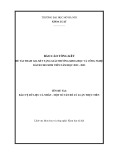
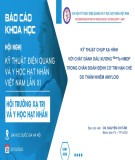

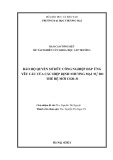
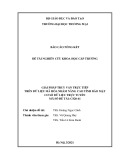
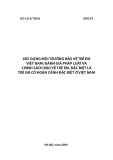

![Vaccine và ứng dụng: Bài tiểu luận [chuẩn SEO]](https://cdn.tailieu.vn/images/document/thumbnail/2016/20160519/3008140018/135x160/652005293.jpg)
